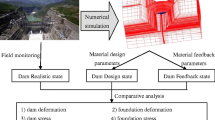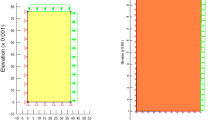Abstract
Occurrence of arching phenomenon in the core of earth dams will reduce vertical stress, piping, and thus the destruction of the dam, so it is always considered an important issue in earth dams. In this study, GeoStudio software was used to investigate the total stress and the arching ratio of the Marvak earth dam at the construction and end of construction phase. In modeling the dam, the behavioral model of Mohr–Coulomb is used and the effect of layer-by-layer embankment construction is also considered. The results of total stress and arching ratio of instrumentation and numerical analysis in the construction and end of construction phase were evaluated and compared. Observational results and results of adaptive modeling show about 95%, which indicates the proper performance of the dam in terms of arching. The results show that with increasing embankment, the total stress also increases, and also, the highest percentage of arching from the beginning to the end of the construction phase is equal to 58% and occurred in the lower one-third of the core level. Due to the high impact of consolidation on arching, the speed and time of construction should be adopted in such a way that part of the consolidation of the lower embankment layers has been done, before the implementation and embankment of the upper layer. In the downstream of the clay core, a higher arching ratio (lower percentage of arching) is observed, which is due to the thicker filter and drainage areas.














Similar content being viewed by others
References
Asakareh A, Ahang M (2017) Numerical study of the arching phenomenon in the nucleus of non-homogeneous tissue of dam located in Kerman province. Civ Eng Modares 17(5):161–168 ((In Persian))
Dunicliff J (1994) Geotechnical instrumentation for monitoring field performance. A-Wiley-Inter science publication, Hoboken
Esmaeilzadeh M, Talkhablou M, Ganjalipour K (2017) Arching parametric study on earth dams by numerical modeling: a case study on Darian dam. Indian Geotech J 48:728–745. https://doi.org/10.1007/s40098-017-0290-2
Ghafari A, Nikraz HR, Sanaeirad A (2016) Finite element analysis of deformation and arching inside the core of embankment dams during construction. Aust J Civ Eng 14(1):13–22. https://doi.org/10.1080/14488353.2015.1092639
Heshmati AH, Yousefi M (2010) Numerical analysis of Dreek Dam and the effect of parameters of Mohr Coulomb’s model on normal stresses of its cluster core. Sharif Publ 38(4):6–16
Jamal A, Niko M, Karimi A (2011) Application of the grouped data grouping model in simulation of sustainability analysis by case study of Alavian dam. In: 15th congress of Iran Geological Society, Tehran
Khamesi SA, Mirghasemi AS (2010) Investigation of hydraulic failure in earth dams. J Civ Surv Eng 44(2):181–191
Kulhawy FH (1976) Load transfer and hydraulic fracturing in zoned dams. J Geotech Eng 9:963–967
Liu Z, Wang C (2016) The analysis of stress, deformation and arch effect of the Lianghekou earth-rockfill dam. Indian Geotech J 46(1):77–84. https://doi.org/10.1007/s40098-015-0154-6
Maksimovic M (1973).Optimal position of central clay core of rock-fill dam in respect to arching and hydraulic fracture. In: International congress on large dam, pp 789–800
Mirghasemi AH, Tavalloly A (2000) Three-dimensional analysis of stress transfer at the clay core of earth dams located in the Tang valleys. In: 4th Conference on dam construction, Tehran.
Norighidari MH, Aliolahi H, Mollaei R (2014) Study of coefficient arching and main stresses in Golabar Dam using numerical analysis and its comparison with instrumental results. In: National conference on architecture, Civil engineering and urban development, Tabriz
Salari M, Akhtarpour AS, Ekrami Fard A (2017) Occurrence of hydraulic failure in the rocks of the mile of long dams located in the narrow valley. J Modares Civ Eng 17(5):102–109
Sherard JL (1986) Hydraulic fracturing in embankment dam. J Geotech Eng 112(10):905–927
Szostak A, Chrzanowski A, Massiéra M (2005) Use of deformation monitoring results in solving geotechnical problems case studies. Eng Geol 79:3–12
Acknowledgment
The authors would like to thank the Abfan Consulting Engineers Co for consultation, etc.
Author information
Authors and Affiliations
Corresponding author
Rights and permissions
About this article
Cite this article
Beiranvand, B., Komasi, M. Study of the Arching Ratio in Earth Dam by Comparing the Results of Monitoring with Numerical Analysis (Case Study: Marvak Dam). Iran J Sci Technol Trans Civ Eng 45, 1183–1195 (2021). https://doi.org/10.1007/s40996-020-00519-1
Received:
Accepted:
Published:
Issue Date:
DOI: https://doi.org/10.1007/s40996-020-00519-1




